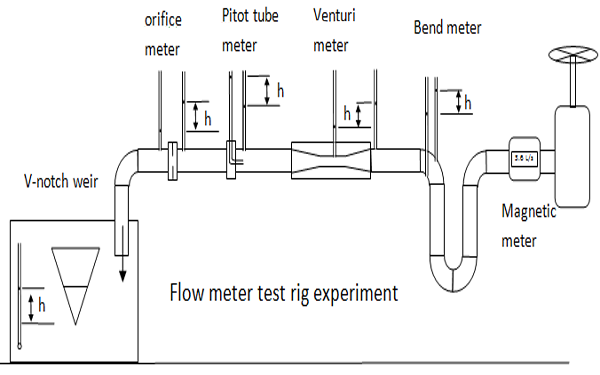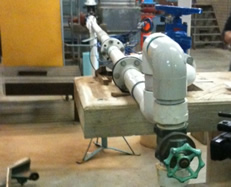Apparatus

In this practical, water flows through a pipe (Nominal pipe diameter = 80 mm) containing a series of different devices.
The first is a magnetic meter, which is simply used to provide an accurate measurement of flow rate against which we will be calibrating the other devices. The next four devices in the pipe all rely on the measurement of a differential pressure which we use to infer the velocity from the energy equation.
For all of these meters, two “tapping points” have been attached to allow pressure to be measured. These are all connected by small pipes to a central manifold and differential manometer (see photos) where the readings are taken.
At the end of the pipe, water empties into a short open channel containing a V-notch weir (in this experiment, θ = 30 degrees). This provides a further opportunity to measure flow by recording the height of water above the crest. A clear plastic tube is attached to the side of the channel alongside a ruler, to provide an accurate reading of water level.
The individual devices are:
1. Bend meter – this simple device relies on the water moving at different velocities on the inside and outside of a bend. From the energy equation we know that this difference in velocity will correspond to a measurable pressure difference.
2. Venturi meter – this is a classic flow measurement device, where water is passed through a narrow throat (throat diameter = 38 mm) in order to induce a higher velocity. Pressure is measured upstream and in the throat, to give the two values corresponding to high and low velocity.
3. Pitot tube – this device is useful for measuring high flows as it results in minimal disruption to the flow. A tube is inserted into the flow such that the water at the entrance of the tube stagnates. The pressure measured in this tube (the “stagnation pressure”) is equal to the pressure head plus velocity head. By comparing against a measurement of pressure head (“static pressure”) taken in the main flow field nearby, the difference between these measurements will be the velocity head.
4. Orifice meter – this is like a crude version of a Venturi meter and follows exactly the same principles by forcing water through a smaller section. The only physical difference between the two devices is that the orifice is simply a flat plate (perpendicular to the direction of the flow) with a hole in it (orifice diameter 26 mm), whereas a Venturi contains a gradual contraction and expansion. The result of this is that the orifice meter induces a far great pressure difference (and head loss) for a given velocity.


These images are of the rig for the pipe flow experiment showing the conduit (left) and the manometer (right).